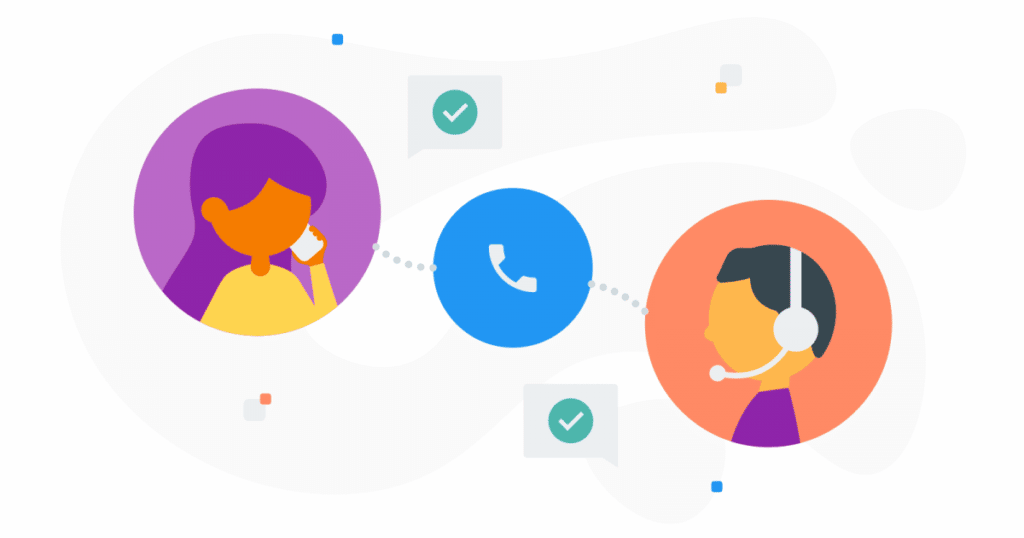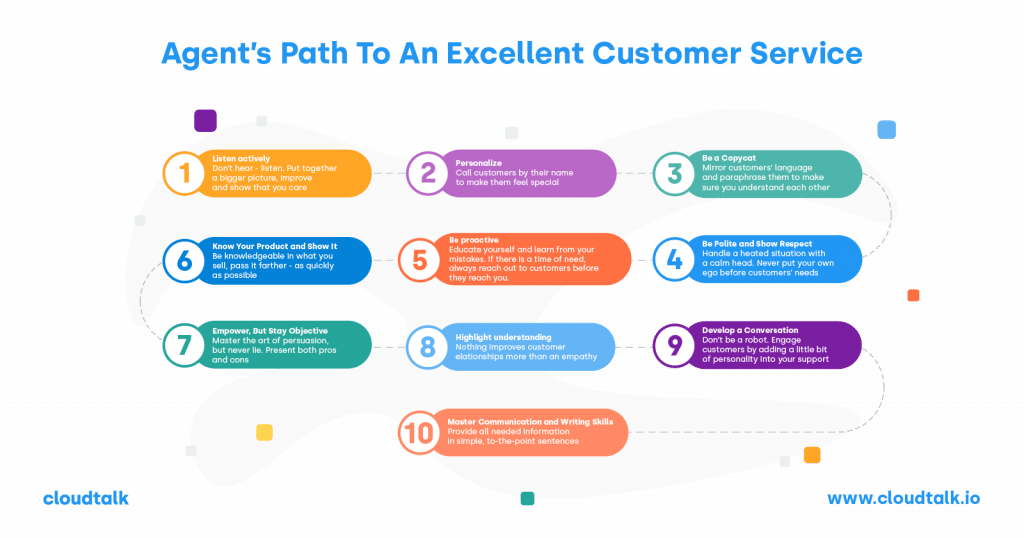10 Effective Customer Service Techniques that Will Make Customers Love You

You can have the greatest product on the market. If your customer service isn’t good, you will start losing clients. Author Pete Blackshaw claims that a satisfied customer confides his positive experience to around 3 people. Yet, an angry person can share it with thousands. Around 83% of unsatisfied clients react by posting their complaints on social media. In contrast, 73% of customers claim that friendly customer support is what made them fall in love with the brand.
These findings showcase how vital is the role of customer service for your business. It impacts retention, account growth, trust and overall satisfaction.
Boosting your customer service from average to outstanding certainly won’t happen from one day to another. Yet, these 10 innovative customer service techniques will get you there sooner than you may expect.
Why is Customer Service Crucial For Your Company?
The interaction with agents helps to create an overall image of your brand. A lot of times, customer support is the initial encounter a client or prospect has with your company. A first impression matters and it’s crucial to make it as positive as possible.
According to an Oracle report, 86% of clients quit doing business with a company because of a bad experience with their stuff. It is estimated that on average, businesses in the USA lose more than 62 billion dollars annually due to poor customer service.
Yet the same percentage, 86% of respondents claim that they are willing to pay more money to a company that provides outstanding support. That is approximately 7 people out of 10. Therefore, a quality customer service is a great revenue generator.
3 Customer Service Tips for Your Business
Before you start to work on your support agents’ performance, here are several innovative tips that may be incorporated on the side of the company.
#1 Build Contextual-based Support
Your agents need to have a full overview of your customer’s cases. When they see the cases in complexity, agents can come up with better solutions and improve customer satisfaction. Microsoft report claims that 75% of clients expect agents to already be familiar with their previous interactions.
Offer your agents helpful tools. Such as call notes, contact history or ability to root call to preferred agent who was previously in contact with the given client.
#2 Innovate Your Channels
Another customer support tip: You need to make sure you follow the latest trends. They change pretty quickly. Experience management company Walker Information made a survey with more than 300 professionals from the B2B sector. It is about the future trends in customer service. Around 68% of respondents claimed that online communities will prevail, with 63% agreeing on social media and 61% on corporate websites.
This is why you should incorporate new online channels into your customer service strategy. Find your clients where they are and offer them a convenient way of contacting you, such as Live Chat.
Upgrading those channels with modern customer feedback tools can provide invaluable insights into the customer experience. By leveraging tools like surveys, comment sections, and sentiment analysis, you can gather real-time feedback to continuously improve your services and address customer concerns promptly.
It is also crucial to innovate internal communication with new approaches. This way, you create a safe place where employees can ask questions easily and find solutions to customers’ issues. You can use Slack channels, Office Vibe polls or forums.
#3 Balance Human Touch and Automation
Unplanned churn can cause a significant loss in revenue. According to CallMiner’s report, a huge amount of people are either leaving or considering leaving companies for reasons that could have been easily avoided. Those are, for example, repetitive manual tasks.
The human touch is still important and should not be completely replaced. But if you won’t eliminate boring duties, your agents won’t feel challenged and will eventually leave you.
Using automation can eliminate repetitive tasks, boost efficiency of your service and reduce missed opportunities. You may, for example, use CRM integration tools to take pressure from trivial tasks off your agents’ shoulders. That allows them to work on more complex cases, such as building loyalty and relationships with customers.
Learn How To Provide Excellent Customer Service
10 Customer Service Tips and Tricks for Your Agents
Now know how to create an environment where your support team can strive. Let’s take a look at qualities agents should master for the best performance.
#1 Listen Actively
People often interpret listening as hearing the words another person says. That is partly true. But even more important is to focus on what is the actual meaning in between the lines. Customers rarely tell you: “Hey, you need to work on your user interface”.
They say something like: “I cannot find where to change my password”. Your agents don’t only have to help with the specific request, such as explaining where to change the password. They should also put together a bigger picture. What can the company do better to eliminate this issue?
Another strong reason why to listen carefully – Clients need to feel fully understood at the first time. If you aim to build strong relationships, asking them to repeat themselves is out of the picture.
Tips on how to improve listening:
Do your agents have problems focusing on what clients are telling? Incorporating these simple tactics to your training sessions.
Echoing: Encourage agents to repeat the last words of the conversation. In their head, of course. This ensures they are actively thinking about the customer’s words. Also, it helps them to connect bits of information into complex units.
It may look like this:
Customer: “Hello. I have a problem with logging into my account. I keep getting an error pop-up,”
Agent: “Okay, account login shows an error message.”
Calling blind: if possible, it may help having eyes closed while on the phone. This eliminates vision and gives more space to the more needed sense – hearing.
Listening indicators: This tactic is not recommended while interacting face to face. Though, it may be profitable during conversation where two parties don’t see each other.
From time to time, your agents can say something like “I see” or “Yes”. This indicates that they are still on the line, listening carefully. It also shows genuine interest.
#2 Call Customers by Their Name
Another handy customer service tip recommends referring to clients by names. This supports personalisation and builds a feeling of importance. It also shows that your agents consider them as individuals and know who they’re talking to. By doing so, your team leaves a great impression. They, too, build a close relationship between handler and caller.
Tips on how to remember names:
Did you even forget someone’s name almost immediately after introduction? This is caused by focusing on our own interactions rather than on the other person. We think about what we will say next. Such as what may be the issue of discussion, how to make a good impression, and so on.
The name is something our brain automatically pushes into the background. It’s considered as only a random bit of information that seems unimportant on a larger scale. To focus your attention on the name of a client, encourage your agents to try following techniques:
- Connection with someone we know: This is a well-known memory trick. When customers introduce themselves, agents need to associate the name to something they know. Such as a friend, an actor, a character they like, etc. It needs to be someone truly memorable, so she/he won’t easily slip the mind.
- Meet and Repeat: After introduction, agents need to repeat the customer’s name in their head. It is also good to mention the name through the whole conversation to really memorize it for future interactions.
#3 Be a Copycat
Agents can try mirroring customers’ way of speaking. Their choice of language, the way they phrase sentences. That creates a feeling that you are on the same boat and supports mutual understanding. It is easier for both agent and client. They can solve the issue quickly, as well as receive the information they seek.
Another useful customer service tip is to paraphrase customers and make summaries of their issues. For example: “So, what you are saying is that you have an issue with the sound quality, am I right?” This isn’t the same as not listening or letting customers repeat themselves.
Quite the opposite. It shows that the agent was truly paying attention and is deeply invested in solving the issue. It also ensures that there will be no delays in problem solving due misunderstandings.
#4 Be Polite and Show Respect
Gratitude is what truly ensures customers that they made a good choice purchasing your product. It should go without saying that please and thank you are key communication factors. But that is the easier part.
Great Customer support often goes hand in hand with emotions. And not always positive ones. Clients call with many issues that frustrates them. Or maybe they simply have a bad day. This is what support agents cannot avoid – learning how to handle emotional situations politely and respectfully.
They should never let their own emotions overtake the satisfaction of a customer. The key of this is not taking things personally. Clients are not upset with an agent, they are upset for some fallback with the product. Agent is simply there to listen and support.
Starting conversation with a positive vibe can help to beat the negativity. Encourage agents to start with a warm greeting and a smile. It may sound silly, but the smile is hearable in the tone of our voice. That creates a friendly impression.
#5 Be proactive
Assure that your agents are being proactive towards themselves and towards clients. What do we mean by this customer service tip?
Towards themselves: All quality agents should be willing to accept feedback and grow. Educate themselves. Even the best of the best still need to learn. Practise makes perfect and it’s a never ending process. Encourage agents to acknowledge their mistakes. If they master this, your company’s services will excel.
Towards customers: Clients seek for companies that are proactively reaching to them. To provide an example, let’s say one of your products will be temporarily unavailable or your website is out of order. Customers may not be happy about it. But they will highly appreciate it if they’ll receive an email to find out upfront. This tactic is certainly better than letting them discover by themselves. That way, you will receive angry phone calls or negative reviews.
#6 Know Your Product and Show It
Improve knowledge: This customer service technique plays one of the biggest roles in clients’ experience. It showcases competency. No one wants to communicate with an incompetent agents.
They need to be familiar with the product and the company from front to back. More knowledgeable agents are, the more competent they become. A strong foundation and experience builds understanding of complex problems that may not always be straightforward.
PRO TIP: During the onboarding process, it is strongly recommended to “equip” each agent with a product specialist who can pass the knowledge and help.
Be fast: If you know your product perfectly, master how to show it. Quick answers are crucial. Around 41% of customers perceive being put on hold as the biggest source of frustration. Therefore, don’t let your customers wait.
Also, if you are overloaded by cases and cannot answer all the calls, you may incorporate a voicemail feature. Thanks to that, customers get the option to leave a message instead of queuing.
Furthermore, make sure agent’s have enough technical knowledge of your own system. In order to be fast, they need to know how to operate each tool perfectly. If someone doesn’t know where to search for information, it wastes callers’ time.
That is one of the reasons why you can profit from choosing an intuitive call center software like CloudTalk. Thanks to our advanced integrations, you have everything available at one place.
#7 Empower, But Stay Objective
Not all clients who contact support seek help with an issue. Some of them are interested in purchasing your product and want to know more details. A great customer service trick is to master an art of persuasion.
It helps a lot if your agents know how to convince prospects that your product is the best choice for them. It would be a shame to let customers slide away just because your agents can’t offer persuasive, compelling answers.
One of the cornerstones of persuasion is an ability to make minor changes in conversation patterns. How your agents phrase things is extremely important. As it’s the base of all sales, they should always use positive language. Therefore, show prospects a bright side of things.
Let’s say that there’s a product that is currently out of stock. Imagine that the agent says: “I’m very sorry, but we can’t provide this item, since it’s out of stock until next month.” The prospect is likely to say thank you and reach out to another company. One who provides the product immediately.
Instead, agents can say this: “This product will be back in stock next month. I can create a pre-order and make sure it will be delivered to you as soon as it hits the warehouse.” The second approach not only assures the customers they will get his product. It also shows that an agent truly wants to help.
Yet, while using persuasion, always stay real. Don’t encourage your agents to lie withhold facts – it will backfire on you. Tell them to present both pros and cons.
Only by knowing both strengths and weaknesses, the customer can make an informed decision that suits his business’ needs. Otherwise you’ll only end up with an unsatisfied client and wounded reputation. Admitting that you are not perfect also makes you look more credible and trustworthy.
#8 Highlight understanding
Theodor Roosevelt once said: Nobody cares how much you know, until they know how much you care.
There’s a lot of truth in this statement. How many times have you felt better only because someone showed compassion? A truly quality customer service agent should know how to relate to anyone. In any situation.
Empathy may sound more like a character trait than a skill, but it is improvable. Implementing a structured empathy training for customer service can lead your agents towards understanding where the issue comes from, so they can show sincere care. When treated nicely, customers will feel heard and uplifted. Understanding can make all the difference between good and bad customer experience. Even in cases when clients didn’t hear what they wanted to hear.
Tips on how to improve empathy
Feel, Felt, Found: This strategy leaked several years ago, first being used by Apple service representatives. Apple Geniuses, knowledgeable stuff you can find in stores, literally changed doubts to sales by using empathy. So, what does Feel, Felt, Found represent?
Feel: Grasp how the customer feels in the moment. Show that you understand.
Felt: Relate to their issue. Tell them that you, yourself, once felt that way.
Found: Explain how you discovered your doubt was not relevant.
Heard: This tactic originates in another giant brand – Disney. The shortcut stands for Hear, Empathise, Apologise, Resolve and Diagnose.
Hear: Listen to customer’s issue
Empathise: Build trust by showing that you understand and want to help
Apologise: To extent your empathy, demonstrate you feel sorry for the situation
Resolve: Do everything you can to solve the issue
Diagnose: Prevent the issue from happening in the future
Pretend you are talking to yourself: Old but gold. Your agents can present they are the ones who experience an issue. How would they like to be treated? What would they want as an outcome? Talking to yourself is sometimes beneficial.
#9 Develop a Conversation
Encourage agents to mix a problem solving process with conversation. Customers prefer to talk to a person. Not a robot that only asks questions and gives orders.
Of course, agents shouldn’t talk about weather, nor share their life story. But they can choose something relevant. Either connected to the issue the customer is experiencing or whatever is client purchasing. It’s nice to mention the agents’ personal experience with the item. They can also emphasise that the product the customer chose is a very good solution for their business.
Don’t forget to ask your customers for feedback. Let them rate their experience, so both you and your support team can learn directly from the source. Find out what needs to be improved. For example, you can incorporate an email, phone, or any other customer feedback survey. You may also get insights and valuable data from call center software tools. Such as call statistics, call monitoring or emotion analytics.
#10 Master Communication and Writing Skills
Customer support agents are literally a voice of your company. That is why excellent communication skills are crucial – in any form. Agents have to be able to present complex concepts and technical steps in an easy-to-understand manner. That is because people retain structured information 40% more accurately than unstructured one.
If your agents provide too long, vague and over-complicated troubleshooting, not only will your customers lose time. They will most probably end up confused. Therefore, the problem may remain unsolved and the client may remain unsatisfied.
Writing is even more tricky. Having an ability to construct sentences with clarity and compassion is one of the most overlooked and underestimated qualities of a good customer service agent. Unlike phone communication, writing lacks every kind of sensual feedback.
While speaking, it is hearable if we are friendly or frustrated. But in writing, it is agents’ role to set the mood with nothing more than letters. There may be a thin difference between sounding rude and sounding caring.
For example, if your agents write “You need to change your password”, it may sound like they want to get rid of the customer as soon as possible.
The better phrasing would be: “You are experiencing this issue because your password requires a change out of security reasons. Changing it will solve your problem in no time. Is there anything else I can assist you with?”
Of course, it should go without saying that proper grammar is a necessity in both spoken and written communication.
Tips for better explanation strategies:
These three innovative customer service techniques may help your agents to form more comprehensive troubleshooting.
What? So what? Now what?: This strategy holds a simple guide of how to construct sentences the way that they add up to each other. Start with what is the problem, continue with why it is happening and end up with how to solve it.
Example: “What you’re experiencing is a security issue. System requires password change to protect your data. Changing your password will therefore solve everything.”
Problem – Solution – Benefit: This tactic is often used in sales. You start with addressing a problem. Continue with offering a solution and end up with the benefit of the solution.
Example: “Your system requires you to change the password. It is enough to renew it in the system. This is a necessary step to protect your valuable data.”
ELI5: It stands for “Explain it Like I’m 5 (years old)”. In this strategy, simplicity is the key. Of course, don’t take it literally. Your agents shouldn’t speak to their customers like they would be talking to children. But instead of using technical terms, they skip all the reasoning and proceed to direct step-by-step instructions.
Example: Instead of “compress your file”, they say: “Right-click on the icon and select Compress the file.”

Conclusion
For exceptional results, you need an exceptional support team. And for an exceptional support team, you need to incorporate innovative customer support techniques. Remember, agents are direct representatives of your brand.
First, ensure your business offers an ideal environment for striving. Build contextual-based support. Follow trends in communication channels. Balance forces between human and automation.
Just then, you can start to guide your agents towards their best performance. Use our customer service tips and tricks. If your support team truly excels in their job, it will be easy for customers to fall in love with your brand.
An easy-to-grasp, effective virtual phone software can also be of a big help. It’s easier to handle cases when every information you need is on the tip of your finger. In CloudTalk, we offer many useful features. Those make your agents’ work easier and let them focus on what matters – building positive customer relationships.























